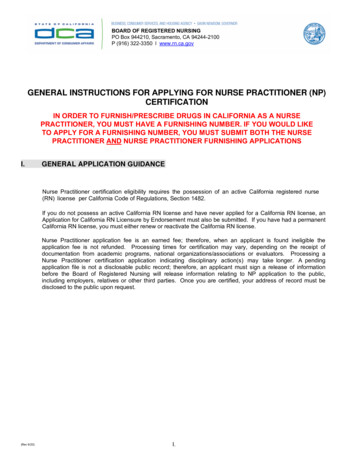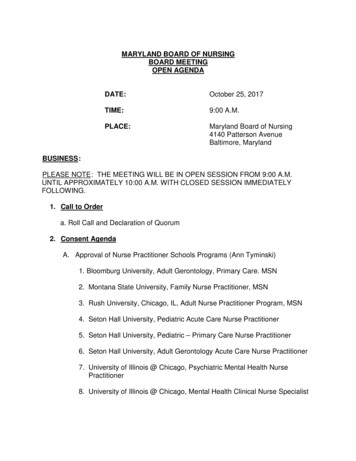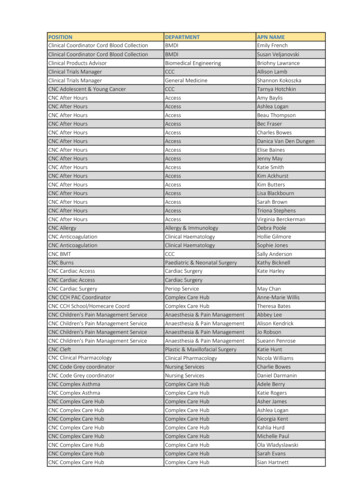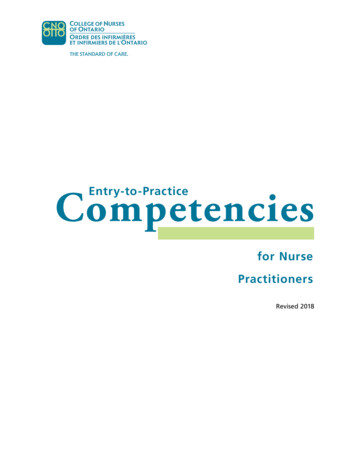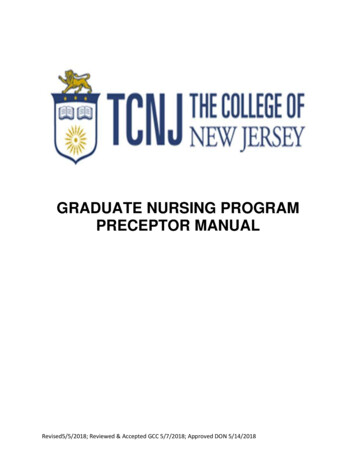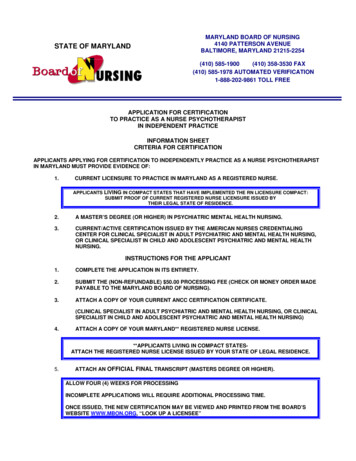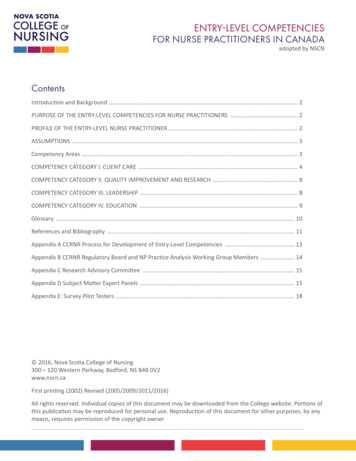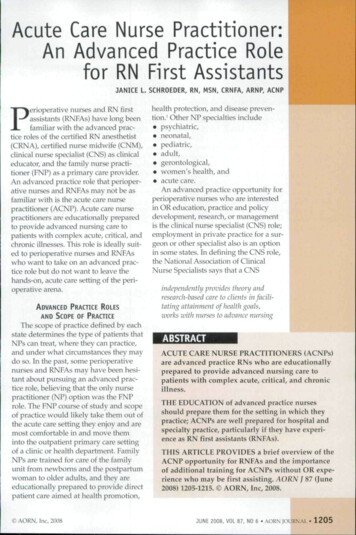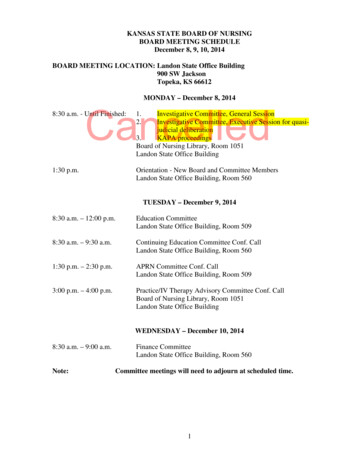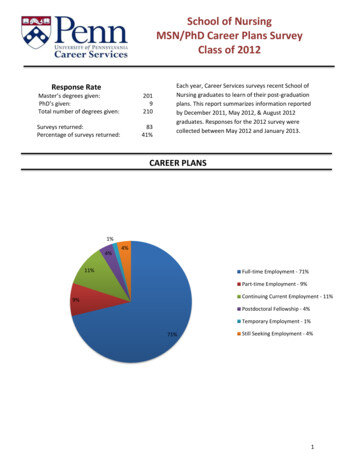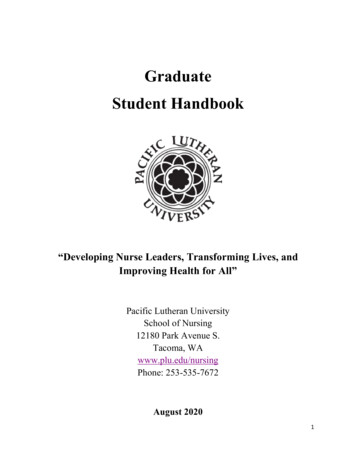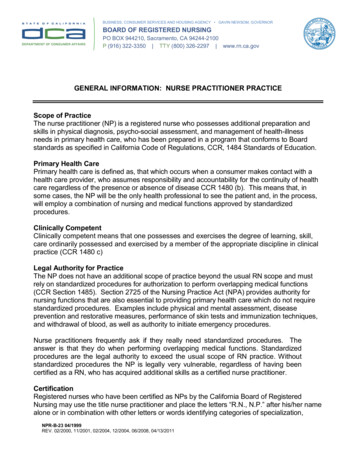
Transcription
BUSINESS, CONSUMER SERVICES AND HOUSING AGENCY GAVIN NEWSOM, GOVERNORBOARD OF REGISTERED NURSINGPO BOX 944210, Sacramento, CA 94244-2100P (916) 322-3350 TTY (800) 326-2297 www.rn.ca.govGENERAL INFORMATION: NURSE PRACTITIONER PRACTICEScope of PracticeThe nurse practitioner (NP) is a registered nurse who possesses additional preparation andskills in physical diagnosis, psycho-social assessment, and management of health-illnessneeds in primary health care, who has been prepared in a program that conforms to Boardstandards as specified in California Code of Regulations, CCR, 1484 Standards of Education.Primary Health CarePrimary health care is defined as, that which occurs when a consumer makes contact with ahealth care provider, who assumes responsibility and accountability for the continuity of healthcare regardless of the presence or absence of disease CCR 1480 (b). This means that, insome cases, the NP will be the only health professional to see the patient and, in the process,will employ a combination of nursing and medical functions approved by standardizedprocedures.Clinically CompetentClinically competent means that one possesses and exercises the degree of learning, skill,care ordinarily possessed and exercised by a member of the appropriate discipline in clinicalpractice (CCR 1480 c)Legal Authority for PracticeThe NP does not have an additional scope of practice beyond the usual RN scope and mustrely on standardized procedures for authorization to perform overlapping medical functions(CCR Section 1485). Section 2725 of the Nursing Practice Act (NPA) provides authority fornursing functions that are also essential to providing primary health care which do not requirestandardized procedures. Examples include physical and mental assessment, diseaseprevention and restorative measures, performance of skin tests and immunization techniques,and withdrawal of blood, as well as authority to initiate emergency procedures.Nurse practitioners frequently ask if they really need standardized procedures. Theanswer is that they do when performing overlapping medical functions. Standardizedprocedures are the legal authority to exceed the usual scope of RN practice. Withoutstandardized procedures the NP is legally very vulnerable, regardless of having beencertified as a RN, who has acquired additional skills as a certified nurse practitioner.CertificationRegistered nurses who have been certified as NPs by the California Board of RegisteredNursing may use the title nurse practitioner and place the letters “R.N., N.P.” after his/her namealone or in combination with other letters or words identifying categories of specialization,NPR-B-23 04/1999REV. 02/2000, 11/2001, 02/2004, 12/2004, 06/2008, 04/13/2011
including but not limited to the following: adult nurse practitioner, pediatric nurse practitioner,obstetrical-gynecological nurse practitioner, and family nurse practitioner. (CCR 1481)On and after January 1, 2008, an applicant will be required for initial qualification orcertification as a nurse practitioner who has never been qualified or certified as a nursepractitioner in California or in any other state to meet specified requirements, includingpossessing a master’s degree in nursing, a master’s degree in a clinical field related tonursing, or a graduate degree in nursing, and to have satisfactorily completed a nursepractitioner program approved by the board. (Business and Professions Code 2835.5)Furnishing Drugs and DevicesBPC Code Section 2836.1 authorizes NPs to obtain and utilize a “furnishing number” tofurnish drugs and devices. Furnishing or ordering drugs and devices by the nursepractitioner is defined to mean the act of making a pharmaceutical agent or agents availableto the patient in strict accordance with a standardized procedure. Furnishing is carried outaccording to a standardized procedure and a formulary may be incorporated. All nursepractitioners who are authorized pursuant to Section 2831.1 to furnish or issue drug ordersfor controlled substances shall register with the United States Drug EnforcementAdministration.BPC 2836.1 was amended changing furnishing to mean “order” for a controlledsubstance, and can be considered the same as an “order” initiated by the physician.This law requires the NP who has a furnishing number to obtain a DEA number to“order” controlled substances, Schedule II, III, IV, V. (AB 1545 Correa) stats 1999 ch914 and (SB 816 Escutia) stats 1999 ch 749.Furnishing Controlled Substances:The furnishing or ordering of drugs and devices occurs under physician and surgeonsupervision. B&P Code Section 2836.1 extends the NP, who is registered with theUnited States Drug Enforcement Administration, the furnishing authority or “ordering”to include Schedule II through V Controlled Substances under the Uniform ControlledSubstance Act (AB 1196 Montanez) Stats2004 ch 205 § (AB 2560) There arespecified educational requirements that must be met by the furnishing NP who wishesto “order” Schedule II Controlled Substances.Drugs and/or devices furnished or “ordered” by a NP may include Schedule II throughSchedule V controlled substances under the California Uniform Controlled SubstancesAct (Division 10 commencing with Section 11000) of the Health and Safety Code andshall be further limited to those drugs agreed upon by the NP and physician andspecified in the standardized procedure.When Schedule II or III controlled substances, as defined in Section 11055 and 11056 of theHealth and Safety Code, are furnished or ordered by a NP, the controlled substance shall befurnished or ordered in accordance with a patient-specific protocol approved by the treatingor supervising physician. The provision for furnishing Schedule II controlled substances shalladdress the diagnosis of illness, injury, or condition for which the Schedule II controlledsubstance is to be furnished. A copy of the section for the NP’s standardized procedurerelating to controlled substances shall be provided upon request to any licensed pharmacistwho dispenses drugs or devices when there is uncertainty about the furnishing transmittalorder.NPR-B-23 04/1999REV. 02/2000, 11/2001, 02/2004, 12/2004, 06/2008, 04/13/20112
The nurse practitioner with an active furnishing number, who is authorized by standardizedprocedure or protocols to furnish must submit to the BRN an approved course that includesSchedule II Controlled Substances content as a part of the NP educational program or acontinuing educational course with required content on Schedule II Controlled substance.The proof of a Schedule II course received by the BRN will be noticed on the board’s website,www.rn.ca.gov, in the NPF verification section.A prescription pad may be used as transmittal order forms as long as they contain thefurnisher’s name and furnishing number. Pharmacy law requires the nurse practitionername on the drug and/or device container label. The name of the supervisingphysician is no longer required on the drug/device container label as pharmacy lawwas amended BPC 1470 (f) (AB 2660 Leno) stats 2004 ch 191.The nursepractitioner DEA number is required for controlled substances. Therefore, inclusion ofthis information on the transmittal order form will facilitate dispensing of the drugand/or device by the pharmacist.Dispensing MedicationBusiness and Professions Code Section 2725.1 allows registered nurses to dispense(hand to a patient) medication except controlled substances upon the valid order of aphysician in primary, community, and free clinic.Business and Professions Code Section 2725.1 was amended to extend to thefurnishing nurse practitioner authority to dispense drugs, including controlledsubstances, pursuant to standardized procedures or protocols in primary, community,and free clinics. (AB 1545 Correa) stats 1999 ch 914)Effective January 1, 2003, B&P Code Section 2836.1 Furnishing is amended to allow NPs touse their furnishing authority in solo practice per Senate Bill 933 (Figueroa) Chapter 764signed by Governor Gray Davis on September 20, 2002.Authorized Standardized proceduresAdded in legislative session 2003 ch 308 § 34 (SB 819), effective January 1, 20102835.7. (a) Notwithstanding any other provision of law, in addition to any other practices thatmeet the general criteria set forth in statute or regulation for inclusion in standardizedprocedures developed through collaboration among administrators and health professionals,including physicians and surgeons and nurses, pursuant to Section 2725, standardizedprocedures may be implemented that authorize a nurse practitioner to do any of the following:(1) Order durable medical equipment, subject to any limitations set forth in the standardizedprocedures. Notwithstanding that authority, nothing in this paragraph shall operate to limit theability of a third-party payer to require prior approval.(2) After performance of a physical examination by the nurse practitioner and collaborationwith a physician and surgeon, certify disability pursuant to Section 2708 of theUnemployment Insurance Code.(3) For individuals receiving home health services or personal care services, afterconsultation with the treating physician and surgeon, approve, sign, modify, or add to a planof treatment or plan of care.(b) Nothing in this section shall be construed to affect the validity of any standardizedprocedures in effect prior to the enactment of this section or those adopted subsequent toenactment.NPR-B-23 04/1999REV. 02/2000, 11/2001, 02/2004, 12/2004, 06/2008, 04/13/20113
Sign for the Request and Receipt of Pharmaceutical Samples and Devices.Certified furnishing nurse practitioners are authorized to sign for the request and receipt ofcomplimentary samples of dangerous drugs and devices identified in their standardizedprocedures or protocols that have been approved by the physician. (SB 1558 Figueroa stats2002 ch 263) to take effect immediately. This new law amends B&P Code Section 4061 ofthe Pharmacy law to allow CNMs, NPs, and PAs to request and sign for complimentarysamples of medication and devices.Treating STDsAmended into Section 120582 of the Health and Safety Code effective January 1, 2007:(a) Not withstanding any other provision of law, a physician and surgeon who diagnoses asexually transmitted chlamydia, gonorrhea, or other sexually transmitted infection, asdetermined by the Department of Health Services, in an individual patient mayprescribe, dispense, furnish, or otherwise provide a prescription antibiotic drugs to thepatients sexual partner or partners without examination of that patient’s partners.(b) Not withstanding any other provision a nurse practitioner practicing pursuant to BPCSection 2836.1; a certified nurse-midwife practicing pursuant to BPC Section 2746.51;and a physician assistant pursuant to BPC 3502.1 may dispense, furnish, or otherwiseprovide a prescription antibiotic drug to the sexual partner or partners of a patient witha diagnosed sexually transmitted Chlamydia, gonorrhea, or other sexually transmittedinfection, as determined by the Department of Health Services without examination ofthe patient’s sexual partners. (AB 2280 Leno stats 2006 ch ) (AB 648 Ortiz stats2001 ch 835)Workers’ Compensation ReportsSection 3209.10 added to the labor code gives nurse practitioners the ability to cosignDoctor’s First Report of Occupational Injury or illness for a worker’s compensation claim toreceive time off from work for a period not to exceed three (3) calendar days if that authorityis included in standardized procedure or protocols. The treating physician is required to signthe report and to make a determination of any temporary disability. (AB 2919 Ridley-Thomasstats 2005 extends the operation of this provision indefinitely-AB 1194 Correa stats 2001 ch229 effective 2001)Veterans with Disabilities Parking Placards:Section 5007, 9105, 22511.55 of the Vehicle Code is amended to include nurse practitioners,nurse midwives and physician assistants as authorized health care professionals that cansign the certificate substantiating the applicant’s disability for the placard. (AB 2120 Lui stats2007 ch 116)Existing law authorizes the Department of Motor Vehicles to issue placards to persons withdisabilities and veteran with disabilities and temporary distinguishing placards to temporarydisabled persons, to be used for parking purposes. Prior to issuing the parking placard ortemporary placard, the Department of Motor Vehicles requires the submission of a certificate,signed by an authorized health care professional providing a full description substantiatingthe applicant’s disability, unless the disability is readily observable and uncontested. Underexisting law, the authorized health care professional that signs the certificate is required toretain information sufficient to substantiate the certificate, and make the information availableto certain entities request of the department.NPR-B-23 04/1999REV. 02/2000, 11/2001, 02/2004, 12/2004, 06/2008, 04/13/20114
Medical Examination School Bus DriversVehicle Code Section 12517.2 (a) is amended relating to schoolbus drivers driver medicalexamination to Applicants for an original or renewal certificate to drive a schoolbus, schoolpupil activity bus, youthbus, general public paratransit vehicle, or farm labor vehicle shallsubmit a report of medical examination of the applicant given not more than two years prior tothe date of the application by a physician licensed to practice medicine , a licensed advancedpractice nurse qualified to perform a medical examination, or a licensed physician assistant.The report shall be on a form approved by the department, the Federal HighwayAdministration, or the Federal Aviation Administration.Schoolbus drivers, within the same month or reaching 65 years of age and each 12th monththereafter, shall undergo a medical examination, pursuant to Section 12804.9, shall submit areport of the medical examination on a form specified in subsection (a) (AB 139 Bass stats2007, ch 158)Informing patient: Positive and Negative aspects of Blood TransfusionsSection 1645 of the Health and Safety Code is amended to authorize the nurse practitionerand the nurse-midwife who is authorized to give blood may now provide the patient withinformation by means of a standardized written summary as developed or revised by theState Department of Public Health about the positive and negative aspects of receivingautologous blood and direct and nondirected homologous blood to volunteers. (SB 102Migden stat 2007 ch 88)Existing law requires, whenever there is reasonable possibility, as determined by a physician,that a blood transfusion may be necessary as a result of medical procedures, that thephysician, by means of a standardized written summary that is published by the Medical Boardand now by the Department of Public Health and distributed upon request, inform the patient ofthe positive and negative aspects of receiving autologous blood and directed and non directedhomologous blood from volunteers.Medi-Cal Billing: Nurse Practitioner Nationally Certified in a SpecialtySection 14132. 41 of the Welfare and Institutions Code is amended services provided by acertified nurse practitioner shall be covered under this chapter to the extent authorized byfederal law, and subject to utilization controls. The department shall permit a (nationally)certified nurse practitioner to bill Medi-Cal independently for his or her services. If a certified(nationally) nurse practitioner chooses to bill Medi-Cal independently for his or her service, thedepartment shall make payment directly to the certified (nationally) nurse practitioner. For thepurposes of this section, “certified” means nationally board certified in a recognized specialty.SupervisionSupervision of the NP performing an overlapping medical function is addressed in thestandardized procedure and may vary from one procedure to another depending upon thejudgment of those developing the standardized procedure. As an example, in one women’sclinic the supervision requirement for performing a cervical biopsy was that a physician must bephysically present in the facility, immediately available in case of emergency. For all otherstandardized procedure functions, the supervision requirement was for a clinic physician to beavailable by phone.NPR-B-23 04/1999REV. 02/2000, 11/2001, 02/2004, 12/2004, 06/2008, 04/13/20115
The furnishing or ordering of drugs and devices by nurse practitioners occurs under physicianand surgeon supervision. Physician and surgeon supervision shall not be construed to requirethe physical presence of the physician, but does include (1) collaboration on the developmentof the standardized procedure, (2) approval of the standardized procedure, and (3) availabilityby telephonic contact at the time the patient is being examined by the nurse practitioner. Forfurnishing purposes, the physician may supervise a maximum of no more than four (4) NPs atone time. (BPC 2836.1)Supervision of Medical AssistantsNurse Practitioners and Certified Nurse-Midwives may supervise Medical Assistants in“community clinics” or “free clinics” in accord with approved standardized procedures and inaccord with those supportive services the Medical Assistant is authorized to perform (Businessand Professions Code, Section 2069(a)(1); and Health and Safety Code, Section 1204(a) & (b).Medical Board of California link for medical assistanthttp://www.mbc.ca.gov/allied/medical assistant. training.html.Business and Professions Code 2069 (a) (1) and Health and Safety Code 1240 link ishttp://www.leginfo.ca.govSB 111, Chapter 358 (Alpert) was signed by Governor Gray Davis on September 26,2001 and became effective January 1, 2002. Business & Profession Code Section2069(a)(1) and Health & Safety Code 1204 a supervising physician and surgeon at acommunity clinic or free clinic as licensed pursuant to Health and Safety Code 1204may, at his or her discretion, in consultation with the nurse practitioner, nurse-midwife,or physician assistant provide written instructions to be followed by a medical assistantin the performance of tasks or supportive services. The written instructions mayprovide that the supervisory function for the medical assistant for these tasks orsupportive services may be delegated to the nurse practitioner, nurse-midwife, orphysician assistant and that tasks may be performed when the supervising physicianand surgeon are not on site. This delegation to the nurse practitioner or nurse midwifeis limited to those licensed clinics under Health and Safety 1240.Citation and FineNPs, like all registered nurses, are subject to citation and fine for violation of the NPA. Citationand fines are a form of disciplinary action against the RN license and/or certificate. Examples ofviolations which have resulted in citation and fine are using the title “nurse practitioner” withoutbeing certified as a NP by the California BRN and failing to have standardized procedureswhen performing overlapping medical functions. NPs are encouraged to comply with allsections of the NPA to avoid discipline.ReferencesB&P Code, Section 2725 RN Scope of Practice, Section 2834 Nurse Practitioner, CaliforniaCode of Regulation Section 1435 Citations and Fines, Section 1470 Standardized ProcedureGuidelines, Section 1480 Standards for Nurse Practitioners.BRN OfficesSacramento Office: (916) 322-3350For more information, please visit the BRN’s Web site at www.rn.ca.govNPR-B-23 04/1999REV. 02/2000, 11/2001, 02/2004, 12/2004, 06/2008, 04/13/20116
GENERAL INFORMATION: NURSE PRACTITIONER PRACTICE Scope of Practice. The nurse practitioner (NP) is a registered nurse who possesses additional preparation and skills in physical diagnosis, psycho-social assessment, and management of health- illness needs in primary health care, who has been prepared in a program that conforms to Board
